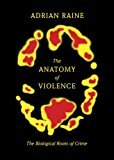A little real life background for "Revenge and Retribution"
If you enjoyed my little story, Revenge and Retribution, and are interested in the psychopath to crime question, or even in other biological factors affecting crime, I am going to give you some links to read: some academic, some general interest.
I think the "nature vs nurture" argument is a little overplayed; in most cases, what causes someone to commit crime is a mixture of influences. People that demand that there is only ONE cause to any human endeavor are usually interested in that so they can put their solution in play. I mentioned Cloward and Piven in the story; that is just one example.
Hare and Raines are both actual researchers; Hare in the study of psychopathy, and Raines in the biological, primarily neurological, factors in crime. I was in attendance at a panel discussion at the 2015 ASC meeting in which Raines did note the hostility of sociologists to biologically based theories. FWIW, I do not hold a doctorate (I did not get into a doctoral program; my master's is CJ with a Homeland Security focus and my own research areas specializes in COINTELPRO and domestic security in relation to the Constitution and the protection of the American citizen). As far as I know, I have never knocked up an Admiral's daughter.
So let's start with a movie; a documentary I saw last night on Amazon Prime, and which kicked off the idea for the story. There is lot of background on the nature of psychopathy, but the idea which caught my attention was the idea of "fixing" psychopaths with a microchip. Actually, there is a whole host of other ethical questions in such treatments that I thought about including in the story, but decided against doing so (constantly slapping myself in the head and yelling SHORT STORY, STEVE). Such microchips are not possible today, but Raines (in the movie) predicts they will be within 10 years.
Psychopath: Redefining Rational

Speaking of Raines, his book is excellent. Although he focuses on biological factors, he constantly stresses that there can be many causes to why a person commits crimes. The section at the end of the book in which he consider the possible ethical problems in discovering genetic markers for criminal or violent disposition is worth reading the book solely on it's own. I think the book can be a difficult read overall, but if you take it in small doses, you'll find it very interesting.
The Anatomy of Violence: The Biological Roots of Crime
A good starter article for general interest would be from The Scientific American, What "Psychopath" Means. I really liked this quote from the article which highlights the universal presence of psychopaths :
In a 1976 study anthropologist Jane M. Murphy, then at Harvard University, found that an isolated group of Yupik-speaking Inuits near the Bering Strait had a term (kunlangeta) they used to describe “a man who … repeatedly lies and cheats and steals things and … takes sexual advantage of many women—someone who does not pay attention to reprimands and who is always being brought to the elders for punishment.” When Murphy asked an Inuit what the group would typically do with a kunlangeta, he replied, “Somebody would have pushed him off the ice when nobody else was looking.”
My own contribution comes from a discussion assignment in grad school; we were comparing sexual sadism to psychopathy. My non-psychologist opinion is that the DSM changes too often to take seriously. The link is PCL-R and SSSS
In my discussion I include the PCL test I mentioned in the story; I do want to note from the original source -
Obviously, diagnosing someone as a psychopath is a very serious step. It has important implications for a person and for his or her associates in family, clinical and forensic settings. Therefore, the test must be administered by professionals who have been specifically trained in its use and who have a wide-ranging and up-to-date familiarity with studies of psychopathy.
For those of you with scholastic access to journals (I forget correct APA styling, and I really don't care!):
Harris, G. T., Rice, M. E., Hilton, N. Z., Lalumière, M. L., & Quinsey, V. L. (2007). Coercive and Precocious Sexuality as a Fundamental Aspect of Psychopathy. Journal of Personality Disorders, 21(1), 1–27.
Mokros, A., Osterheider, M., Hucker, S. J., & Nitschke, J. (2011). Psychopathy and sexual sadism. Law and Human Behavior, 35(3), 188–199. https://doi.org/10.1007/s10979-010-9221-9
Skeem, J. L., & Cooke, D. J. (2010). Is criminal behavior a central component of psychopathy? Conceptual directions for resolving the debate. Psychological Assessment, 22(2), 433–445. https://doi.org/10.1037/a0008512
Walsh, Z., Swogger, M. T., & Kosson, D. S. (2004). Psychopathy, IQ, and violence in European American and African American county jail inmates. Journal of Consulting and Clinical Psychology, 72(6), 1165–1169.
And a very last note:
The only psychopaths that have been studied are the ones that get caught in criminal acts; there are plenty of psychopaths out there that do not indulge themselves in crime, and an undetermined number of them that do commit crimes, and don't get caught.
What that means is that our academic understanding of psychopathy is incomplete!


Nice article. I would also like to add the fact that what we call law is really is moral concepts created by man/governments. Point being if i wanted to make a certain class of people criminal i would tailor/create laws affecting them such as the Jim Crow laws in United States. There is universal law or what some would call God's law. If we really break down law, there would be only one law (stealing). All crime is a form is theft. When you do something wrong to some one, you are taking something from them. Example being their property, there liberty, their life and so on. Good article and great read and hope my comment adds value. Cheers
it certainly does; I talk about mala in se crime versus mala prohibita crime all the time.
mala in se, or "bad in itself", is what I call real crime; murder, rape, robbery, but they all come back to theft.
there is a great quote by the narrator's dad from The Kite Runner
mala prohibita is exactly as you say...what man (for what is government if not man?) decides to make illegal...usually for the sake of his own wallet or feelings of moral supremacy over others
thanks for the comment, and I followed you